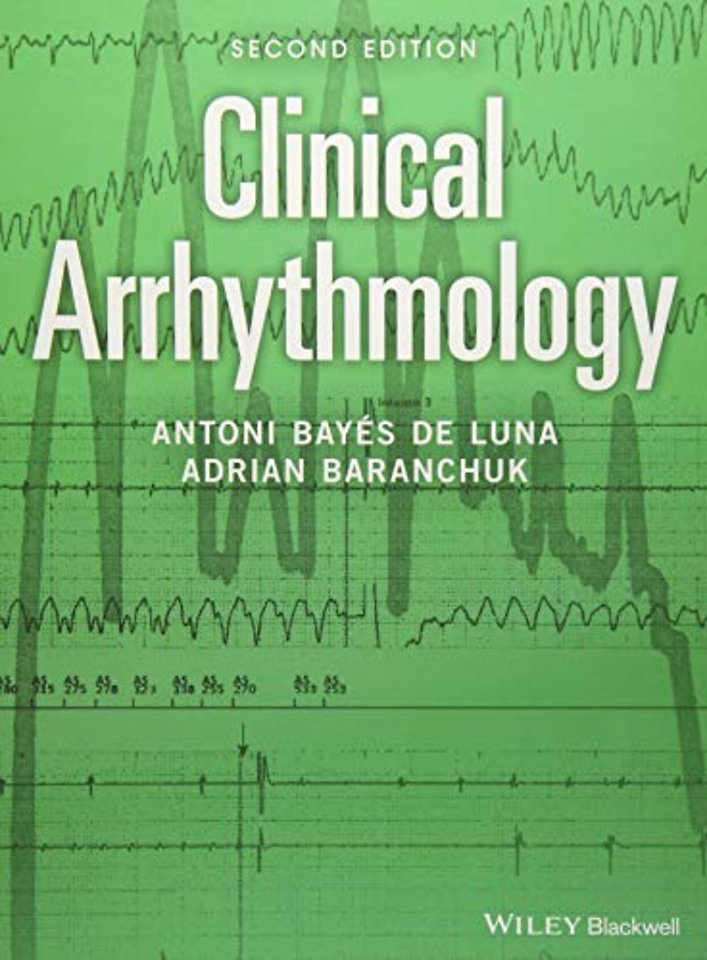

Clinical Arrhythmology, 2nd Edition
Samenvatting
The second edition of
Clinical Arrhythmology provides a fresh, clear, and authoritative overview that will guide readers from a solid understanding of the mechanisms behind cardiac arrhythmias –– which is fundamental to their identification –– to diagnosis via electrocardiograms and other tools, to specific management options for each of the arrhythmias that cardiologists and other clinicians will encounter in clinical practice.
Organized in a clear, intuitive manner; introducing the reader to an understanding of the anatomical and electrophysiological bases of arrhythmias, then to a comprehensive review of how to diagnose the full range of rhythmic abnormalities, and then to a discussion of specific clinical syndromes in which arrhythmias play a part
Highly illustrated chapters ensure key concepts are simpler to understand
Detailed appendices provide quick reference values for diagnostic and therapeutic techniques, and pharmacotherapeutic agents, and Recommendations
Specificaties
Inhoudsopgave
<p>Foreword by Dr. Pere Brugada i Terradellas xi</p>
<p>Preface xiii</p>
<p>Recommended General Bibliography xvii</p>
<p>Part I Anatomical and Electrophysiological Considerations, Clinical Aspects, and Mechanisms of Cardiac Arrhythmias 1</p>
<p>1 Clinical Aspects of Arrhythmias 3</p>
<p>Definition of Arrhythmia 3</p>
<p>Classification 3</p>
<p>Clinical Significance and Symptoms 4</p>
<p>The Importance of Clinical History and Physical Examination in Diagnosis and Assessment of Arrhythmias 18</p>
<p>The Importance of Surface ECG and Other Techniques 21</p>
<p>References 24</p>
<p>2 Anatomic and Electrophysiologic Basis 27</p>
<p>Anatomic Basis 27</p>
<p>Electrophysiologic Characteristics 34</p>
<p>References 51</p>
<p>3 Electrophysiologic Mechanisms 53</p>
<p>Mechanisms Responsible for Active Cardiac Arrhythmias 53</p>
<p>Mechanisms Leading to Passive Arrhythmias 70</p>
<p>References 80</p>
<p>Part II Diagnosis, Prognosis and Treatment of Arrhythmias 83</p>
<p>4 Active Supraventricular Arrhythmias 85</p>
<p>Premature Supraventricular Complexes 85</p>
<p>Sinus Tachycardia 88</p>
<p>Atrial Tachycardia 95</p>
<p>Junctional Reentrant (Reciprocating) Tachycardia 105</p>
<p>AV Junctional Tachycardia Due to Ectopic Focus 112</p>
<p>Chaotic Atrial Tachycardia 115</p>
<p>Atrial Fibrillation 115</p>
<p>Atrial Flutter 139</p>
<p>Supraventricular Tachyarrhythmias and Atrial Wave Morphology: Monomorphic and Polymorphic Morphology 148</p>
<p>Differential Diagnosis of Supraventricular Tachyarrhythmias with Regular RR Intervals and Narrow QRS 149</p>
<p>Electrocardiographic Diagnosis of the Paroxysmal Supraventricular Tachycardias: a Sequential Approach 151</p>
<p>References 155</p>
<p>5 Active Ventricular Arrhythmias 165</p>
<p>Premature Ventricular Complexes 165</p>
<p>Ventricular Tachycardias 174</p>
<p>Ventricular Flutter 200</p>
<p>Ventricular Fibrillation 201</p>
<p>References 205</p>
<p>6 Passive Arrhythmias 209</p>
<p>Escape Complex and Escape Rhythm 209</p>
<p>Sinus Bradycardia due to Sinus Automaticity Depression 209</p>
<p>Sinoatrial Block 212</p>
<p>Atrial Blocks 214</p>
<p>Atrioventricular Block 216</p>
<p>Ventricular Blocks 218</p>
<p>Cardiac Arrest 226</p>
<p>The Pacemaker Electrocardiography 226</p>
<p>Clinical, Prognostic, and Therapeutic Implications of Passive Arrhythmias 234</p>
<p>References 240</p>
<p>7 Analytical Study of an Arrhythmia 245</p>
<p>Determining the Presence of a Dominant Rhythm 245</p>
<p>Atrial Wave Analysis 245</p>
<p>QRS Complex Analysis 246</p>
<p>Atrioventricular Relationship Analysis 248</p>
<p>Premature Complex Analysis 249</p>
<p>Pause Analysis 249</p>
<p>Delayed Complex Analysis 249</p>
<p>Analysis of the P Wave and QRS ]T Complexes of Variable Morphology 249</p>
<p>Repetitive Arrhythmias Analysis: Bigeminal Rhythm 250</p>
<p>Differential Diagnosis Between Several Arrhythmias in Special Situations 252</p>
<p>References 255</p>
<p>Part III The ECG and Risk of Arrhythmias and Sudden Death in Different Heart Diseases and Situations 257</p>
<p>8 Ventricular Pre–Excitation 259</p>
<p>Concept and Types of Pre–Excitation 259</p>
<p>WPW–type Pre–Excitation (Type 1) 259</p>
<p>Atypical Pre–Excitation 268</p>
<p>Short PR Interval Pre–Excitation 268</p>
<p>References 270</p>
<p>9 Inherited Heart Diseases 273</p>
<p>Introduction 273</p>
<p>Cardiomyopathies 273</p>
<p>Specific Conduction System Involvement: Lenegre Syndrome 285</p>
<p>Ionic Channel Disorders in the Absence of Apparent Structural Heart Disease: Channelopathies 285</p>
<p>References 305</p>
<p>10 Other ECG Patterns of Risk 313</p>
<p>Severe Sinus Bradycardia 313</p>
<p>Third–Degree (Advanced) Interatrial Block 313</p>
<p>High–Risk Ventricular Block 317</p>
<p>Advanced Atrioventricular Block 319</p>
<p>The Presence of Ventricular Arrhythmias in Chronic Heart Disease Patients 321</p>
<p>Acquired Long QT 322</p>
<p>Electrical Alternans 325</p>
<p>Other Electrocardiographic Patterns of Risk for Sudden Death 326</p>
<p>Early Repolarization (ER) Pattern (J Wave) and Sudden Death 326</p>
<p>Risk of Serious Arrhythmias and Sudden Death in Patients with Normal or Nearly Normal ECG 329</p>
<p>References 331</p>
<p>11 Arrhythmias in Different Heart Diseases and Situations 335</p>
<p>Ischemic Heart Disease 335</p>
<p>Heart Failure 341</p>
<p>Valvular Heart Disease 345</p>
<p>Congenital Heart Disease 346</p>
<p>Hypertensive Heart Disease 348</p>
<p>Myocarditis 348</p>
<p>Cor Pulmonale 348</p>
<p>Pericardial Disease 348</p>
<p>Sudden Death in Other Heart Diseases 349</p>
<p>Sudden Infant Death Syndrome 349</p>
<p>Athletes 349</p>
<p>Alcohol Intake 351</p>
<p>Special Situations 351</p>
<p>Sudden Death in Apparently Healthy People 354</p>
<p>References 354</p>
<p>Appendix 359</p>
<p>Introduction 359</p>
<p>Calculation of Sensitivity, Specificity, and Predictive Value 359</p>
<p>Diagnostic Techniques 361</p>
<p>Therapeutic Techniques 372</p>
<p>Antiarrhythmic Agents 384</p>
<p>Classification of the Recommendations for Diagnostic and Therapeutic Procedures and Level of Evidence (AHA/ESC/ACC Guidelines) 388</p>
<p>References 389</p>
<p>Index 395</p>